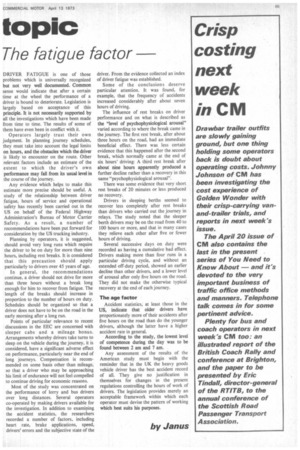topic
Page 67

If you've noticed an error in this article please click here to report it so we can fix it.
The fatigue factor
DRIVER FATIGUE is one of those problems which is universally recognized but not very well documented. Common sense would indicate that after a certain time at the wheel the performance of a driver is bound to deteriorate. Legislation is largely based on acceptance of this principle. It is not necessarily supported by all the investigations which have been made from time to time. The results of some of them have even been in conflict with it.
Operators largely trust their own judgment. In planning journey schedules, they must take into account the legal limits on hours, and the obstacles which the driver is likely to encounter on the route. Other relevant factors include an estimate of the extent to which the driver's own performance may fall from its usual level in the course of the journey.
Any evidence which helps to make this estimate more precise should be useful. A study of the relationship between driver fatigue, hours of service and operational safety has recently been carried out in the US on behalf of the Federal Highway Administration's Bureau of Motor Carrier Safety. As a result, a number of recommendations have been put forward for consideration by the US trucking industry.
Planning by operators, it is suggested, should avoid very long runs which require the driver to be on duty for more than nine hours, including rest breaks. It is considered that this precaution should apply particularly to drivers over 45 years of age.
In general, the recommendations continue, a driver should not drive for more than three hours without a break long enough for him to recover from fatigue. The length of the breaks should increase in proportion to the number of hours on duty. Schedules should be organized so that a driver does not have to be on the road in the early morning after a long run.
Points of particular relevance to recent discussions in the EEC are concerned with sleeper cabs and a mileage bonus. Arrangements whereby drivers take turns to sleep on the vehicle during the journey, it is considered, have a significant adverse effect on performance, particularly near the end of long journeys. Compensation is recommended on some basis other than mileage, so that a driver who may be approaching his limit of endurance will not feel compelled to continue driving for economic reasons.
Most of the study was concentrated on the performance of lorry and bus drivers over long distances. Several operators co-operated by making drivers available for the investigation. In addition to examining the accident statistics, the researchers recorded a number of factors, including heart rate, brake applications, speed, drivers' errors and the subjective state of the driver. From the evidence collected an index of driver fatigue was established.
Some of the conclusions deserve particular attention. It was found, for example, that the frequency of accidents increased considerably after about seven hours of driving.
The influence of rest breaks on driver performance and on what is described as the "level of psychophysiological arousal" varied according to where the break came in the journey. The first rest break, after about three hours on the road, had an immediate beneficial effect. There was less certain evidence that this happened after the second break, which normally came at the end of six hours' driving: A third rest break after about nine hours apparently produced a further decline rather than a recovery in this same "psychophysiological arousal".
There was some evidence that very short rest breaks of 20 minutes or less produced no recovery.
Drivers in sleeping berths seemed to recover less completely after rest breaks than drivers who carried out the journey in relays. The study noted that the sleeper berth drivers may be on the road from 40 to 100 hours or more, and that in many cases they relieve each other after five or fewer hours of driving.
Several successive days on duty were recorded as having a cumulative bad effect. Drivers making more than four runs in a particular driving cycle, and without an extended off-duty period, showed an earlier decline than other drivers, and a lower level of arousal after only five hours on the road. They did not make the otherwise typical recovery at the end of each journey.
The age factor
Accident statistics, at least those in the US, indicate that older drivers have proportionately more of their accidents after five hours on the road than do the younger drivers, although the latter have a higher accident rate in general.
According to the study, the lowest level of competence during the day was to be found between 2 am and 7 am.
Any assessment of the results of the American study must begin with the reminder that in the UK the heavy goods vehicle driver has the best accident record of all. They give no justification in themselves for changes in the present regulations controlling the hours of work of drivers. The legislation provides merely an acceptable framework within which each operator must devise the pattern of working which best suits his purposes.
by Janus
























































































































